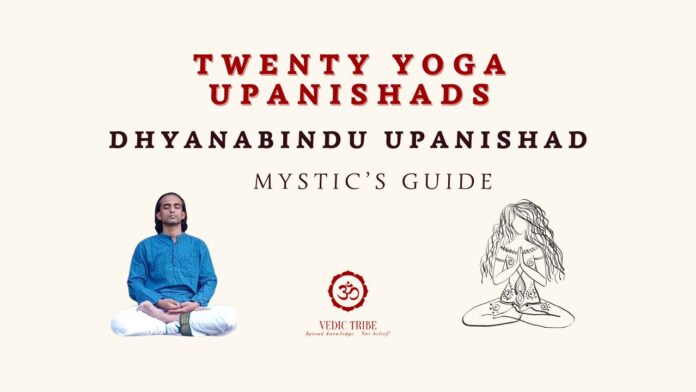What is Prana Vidya?
In the previous article, we discussed Nadabindu Upanishad and in this article, we will – Dhyanabindu Upanishad.
The Upanishad explains Prana Vidya – i.e., meditating upon Parabrahman – the essence of Pranava (Om) residing in one’s own heart as a study flame of lamp. Such a model for meditation is first visualization, then contemplation and then realization.
Dhyanabindu Upanishad discusses Pranava (Om), different model of Shadanga Yoga and lists four essential postures for meditation. It also discusses essential elements for Kundalini Yoga i.e., Chakra, Nadi, ten dimensions of Prana, Bandha, Kechari Mudra and Mahamudra
Shadanga Yoga:
Dhyanabindu Upanishad outlines a six-step yogic process (different from Amruta Nadabindu Upanishad):
1. Posture – Siddhasana, Bhadrasana, Simhasana and Padmasana.
2. Focus on breath and controlling its pace
3. Withdrawing breath,
4. Steadiness of breath
5. Focus of mind
6. Concentration
Kundalini Yoga – a confluence of different ancient teachings:
Kundalini Yoga: Dhyanabindu Upanishad explains Kundalini Yoga, a system of practices aimed at awakening the spiritual energy that lies dormant at the base of the spine. By channelling this energy upwards through the chakras, one can attain higher states of consciousness.
Confluence: In addition to Dhyanabindu Upanishad the exposition on “Kundalini” is found in other Yoga Upanishads too (Trishiki Brahmana, Shandilya, Yogashiksha, Yogakundalini, Darshana…etc). Parallel to Patanjala Yoga and Hatha Yoga, the ancient Kriya-Yoga lineage exclusively dealt in Kundalini. In Tantra tradition specially, Kundalini plays an important role. Hence the authentic Kundalini Yoga is a confluence of teachings in Vedanta Darshana, Yoga Darsha and Tantra Shastra.
In pop-culture: Today, Kundalini Yoga has gained significant popularity among Westerners, especially those involved in cross-cultural movements. However, it’s important to note that many of the contemporary practices are loosely based on liberal spiritual ideas prevalent in popular culture. These practices often deviate from the ancient systems of Yoga and Tantra, which have a rich and rigorous history. The contemporary Kundalini Yoga have no link to any of these teachings. As a result, the contemporary Kundalini Yoga is more of a leisurely entertainment, devoid of the rich spiritual insights of Vedic tradition.
Essential elements for Kundalini Yoga:
Dhyanabindu Upanishad explains some of the profound insights in the Yogic tradition which form the core of Kundalini Yoga.
Chakra: Chakras are the seven energy centers located along the spine. Dhyanabindu Upanishad visualizes these energy centres as lotus flower. Muladhara with four petals; Svadhistana with six petals; Manipura with ten petals; Anahata with twelve petals; Vishuddhi with six petals; Ajna with two petals; and Sahasrara with thousand petals.
Nadi: Nadi is a channel of energy in the body. The Upanishad says our body consists of 72000 Nadis but scriptures speak of only 72. The Upanishad names the major ten as: Ida, Pingala, Sushumna, Gamdhari, Hastijihva, Pusha, Yashwswini, Alambusa, Kuhu and Shankhini. Essential ones for Yogic practice are only three: Ida, Pingala and Sushumna.
Ida Nadi: It is associated with the moon and feminine energy. It originate from the left nostril and ascend along the left side of the spine.
Pingala Nadi: It is associated with the sun and masculine energy. It originate from the right nostril and ascend along the left side of the spine.
Key takeaways:
– Study Dhyanabindu Upanishad and understand its meaning from a scholar and adopt teachings of this Upanishad in your meditative practices.
– If you encounter modern Kundalini Yoga, question its authority and time tested tradition.
In the next article, we will discuss – “Brahmavidya Upanishad”.
Madhwesh K
Vedic Tribe

